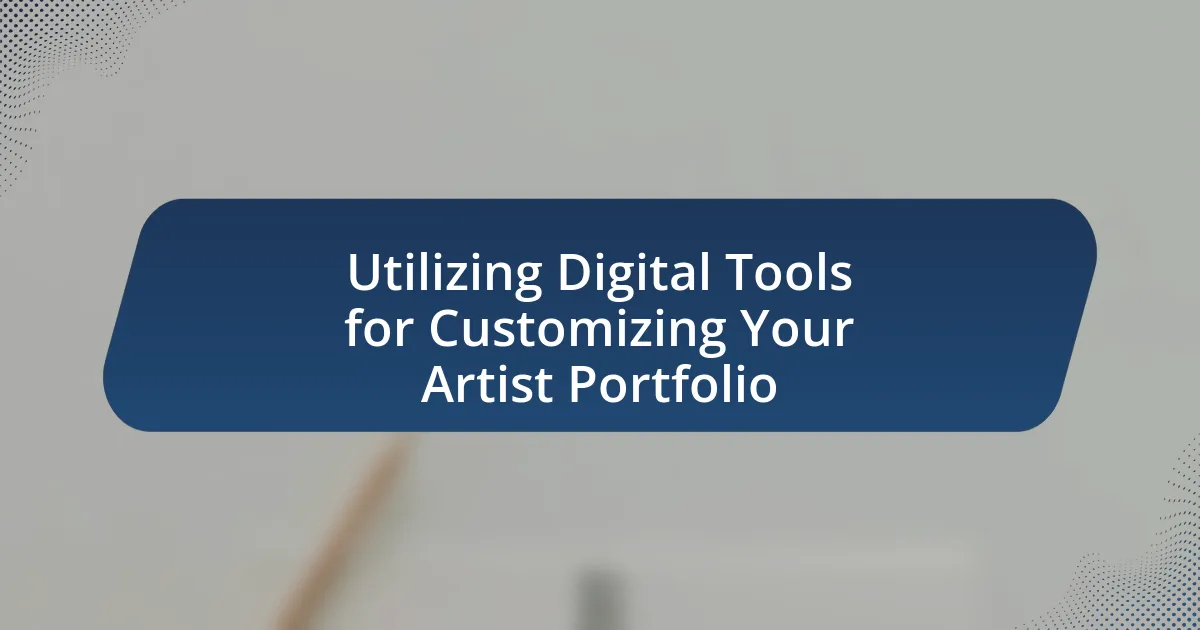User experience (UX) is a critical factor in the effectiveness of online artist portfolios, directly impacting audience engagement and retention. A well-designed UX enhances navigation, visual appeal, and accessibility, which are essential for showcasing artwork and facilitating user interaction. Key elements contributing to a positive user experience include intuitive navigation, high-quality visuals, and responsive design, all of which can significantly influence an artist’s visibility and success in a competitive digital landscape. The article also addresses the consequences of poor user experience, common mistakes to avoid, and practical tips for artists to improve their portfolios, emphasizing the importance of continuous adaptation to emerging trends and technologies in UX design.

What is the Importance of User Experience in Online Artist Portfolios?
User experience (UX) is crucial in online artist portfolios as it directly influences how effectively potential clients and audiences engage with the artist’s work. A well-designed UX enhances navigation, making it easier for visitors to explore artwork, understand the artist’s style, and access contact information. Research indicates that 88% of online consumers are less likely to return to a site after a bad experience, highlighting the importance of a seamless and intuitive interface. Furthermore, a positive UX can lead to increased time spent on the portfolio, higher conversion rates, and ultimately, more opportunities for the artist.
Why is User Experience Critical for Artists’ Online Presence?
User experience is critical for artists’ online presence because it directly influences audience engagement and retention. A well-designed user experience ensures that visitors can easily navigate an artist’s portfolio, find relevant information, and appreciate the artwork without frustration. Research indicates that 88% of online consumers are less likely to return to a site after a bad experience, highlighting the importance of intuitive design and functionality. Furthermore, a positive user experience can lead to increased sharing and recommendations, which are vital for an artist’s visibility and success in a competitive digital landscape.
What elements contribute to a positive user experience in online portfolios?
A positive user experience in online portfolios is primarily contributed by intuitive navigation, visually appealing design, and responsive functionality. Intuitive navigation allows users to easily find information, which is crucial as studies show that 94% of first impressions relate to design and usability. Visually appealing design engages users and reflects the artist’s style, enhancing emotional connection; research indicates that users form opinions about a website within 0.05 seconds based on visual appeal. Responsive functionality ensures that the portfolio is accessible across devices, with 52% of global web traffic coming from mobile devices, emphasizing the need for mobile optimization. Together, these elements create an effective online portfolio that meets user expectations and fosters engagement.
How does user experience impact an artist’s ability to showcase their work?
User experience significantly impacts an artist’s ability to showcase their work by influencing how effectively potential viewers engage with the portfolio. A well-designed user experience facilitates easy navigation, allowing visitors to explore the artist’s creations without frustration. Research indicates that 88% of online consumers are less likely to return to a site after a bad experience, highlighting the importance of intuitive design and accessibility in retaining viewer interest. Furthermore, positive user experiences can lead to increased sharing and recommendations, which are crucial for an artist’s visibility and success in a competitive market.
How does User Experience Influence Audience Engagement?
User experience significantly influences audience engagement by determining how effectively users interact with a website or platform. A positive user experience, characterized by intuitive navigation, fast loading times, and visually appealing design, encourages users to spend more time exploring content. Research indicates that websites with optimized user experiences can see engagement rates increase by up to 400%, as users are more likely to return and recommend the site to others. This correlation highlights the importance of user experience in retaining audience attention and fostering deeper connections with content, particularly in online artist portfolios where visual appeal and ease of access are crucial.
What role does navigation play in user engagement on artist portfolios?
Navigation is crucial for user engagement on artist portfolios as it directly influences how easily visitors can explore content. Effective navigation allows users to quickly find artwork, artist information, and contact details, enhancing their overall experience. Research indicates that 94% of users cite easy navigation as a key factor in their satisfaction with a website, which directly correlates to increased time spent on the site and a higher likelihood of return visits. Thus, streamlined navigation not only improves user experience but also fosters deeper engagement with the artist’s work.
How can visual design enhance user experience for artists?
Visual design enhances user experience for artists by creating an engaging and intuitive interface that showcases their work effectively. A well-executed visual design can guide users through the portfolio, making it easier to navigate and appreciate the artist’s creations. For instance, studies show that aesthetically pleasing designs can increase user engagement by up to 200%, as users are more likely to stay longer and explore more content when the visual elements are appealing. Additionally, effective use of color, typography, and layout can evoke emotions and convey the artist’s brand identity, further enriching the user experience.
What are the Consequences of Poor User Experience?
Poor user experience leads to decreased user engagement and higher bounce rates. When users encounter difficulties navigating a website or finding information, they are more likely to leave the site quickly, resulting in lost opportunities for artists to showcase their work. Research indicates that 88% of online consumers are less likely to return to a site after a bad experience, highlighting the critical impact of user experience on retention. Additionally, poor user experience can damage an artist’s reputation, as users may associate the quality of the portfolio with the quality of the artwork. This correlation underscores the importance of a well-designed user interface in attracting and retaining potential clients or fans.
How does a negative user experience affect an artist’s reputation?
A negative user experience significantly harms an artist’s reputation by diminishing audience engagement and trust. When users encounter difficulties navigating an artist’s online portfolio, such as slow loading times or confusing layouts, they are likely to leave without exploring the artist’s work further. Research indicates that 47% of users expect a webpage to load in two seconds or less, and 40% abandon a site that takes more than three seconds to load. This abandonment can lead to negative perceptions of the artist’s professionalism and quality. Additionally, negative experiences can result in unfavorable reviews and social media backlash, further tarnishing the artist’s public image. Thus, a poor user experience directly correlates with a decline in an artist’s reputation.
What common mistakes lead to poor user experience in online portfolios?
Common mistakes that lead to poor user experience in online portfolios include slow loading times, lack of mobile optimization, and unclear navigation. Slow loading times can frustrate users, with studies indicating that a one-second delay can reduce conversions by 7%. Lack of mobile optimization alienates a significant portion of users, as over 50% of web traffic comes from mobile devices. Unclear navigation makes it difficult for users to find information, leading to increased bounce rates; research shows that 38% of users will stop engaging with a website if the content or layout is unattractive. These factors collectively diminish the effectiveness of an online portfolio, hindering user engagement and satisfaction.
How can Artists Improve User Experience in Their Portfolios?
Artists can improve user experience in their portfolios by ensuring intuitive navigation and visually appealing layouts. Intuitive navigation allows users to easily find artworks and information, which can be achieved through clear menu structures and categorization of works. Visually appealing layouts engage users and can be enhanced by using high-quality images, consistent color schemes, and responsive design that adapts to various devices. Research indicates that 94% of first impressions relate to design, highlighting the importance of aesthetics in user engagement. Additionally, incorporating features like search functionality and social media integration can further enhance user experience by making it easier for visitors to explore and share content.
What best practices should artists follow for effective portfolio design?
Artists should follow best practices such as showcasing a cohesive body of work, ensuring high-quality images, and providing clear navigation for effective portfolio design. A cohesive body of work helps convey an artist’s unique style and vision, while high-quality images enhance visual appeal and professionalism. Clear navigation allows viewers to easily explore the portfolio, improving user experience. Research indicates that 94% of first impressions relate to design, emphasizing the importance of these elements in engaging potential clients and audiences.
How can feedback be utilized to enhance user experience?
Feedback can be utilized to enhance user experience by systematically collecting and analyzing user input to identify pain points and areas for improvement. This process allows designers and developers to make informed adjustments that align with user needs and preferences. For instance, a study by Nielsen Norman Group found that usability testing, which incorporates user feedback, can lead to a 50% increase in task success rates. By implementing changes based on specific feedback, such as simplifying navigation or improving content clarity, online artist portfolios can significantly improve user satisfaction and engagement.

What Tools and Techniques Enhance User Experience in Online Portfolios?
Tools and techniques that enhance user experience in online portfolios include responsive design, intuitive navigation, high-quality visuals, and interactive elements. Responsive design ensures that portfolios are accessible on various devices, improving usability; for instance, 52% of users are less likely to engage with a company if the mobile experience is subpar. Intuitive navigation allows users to find information quickly, which is crucial as 38% of users will stop engaging with a website if the content is unattractive. High-quality visuals, including images and videos, capture attention and convey professionalism, as studies show that visual content is processed 60,000 times faster than text. Interactive elements, such as animations or hover effects, can increase user engagement by making the experience more dynamic and enjoyable.
Which platforms offer the best user experience for artists?
Platforms that offer the best user experience for artists include Behance, Adobe Portfolio, and Squarespace. Behance provides a visually appealing interface and community engagement features, allowing artists to showcase their work and receive feedback. Adobe Portfolio integrates seamlessly with Adobe Creative Cloud, enabling easy updates and customization. Squarespace offers a range of templates specifically designed for artists, ensuring a professional presentation of their portfolios. These platforms are recognized for their user-friendly designs, customization options, and community support, making them ideal for artists to effectively display their work.
What features should artists look for in portfolio-building platforms?
Artists should look for user-friendly interfaces, customizable templates, and mobile responsiveness in portfolio-building platforms. A user-friendly interface ensures that artists can easily navigate and manage their portfolios without technical difficulties. Customizable templates allow artists to showcase their unique style and branding effectively, while mobile responsiveness ensures that their portfolios are accessible on various devices, enhancing viewer engagement. According to a study by the Nielsen Norman Group, 94% of first impressions relate to design, highlighting the importance of these features in creating a positive user experience.
How do responsive designs contribute to user experience?
Responsive designs enhance user experience by ensuring that websites adapt seamlessly to various screen sizes and devices. This adaptability leads to improved accessibility, allowing users to navigate and interact with content easily, regardless of whether they are using a smartphone, tablet, or desktop. Research indicates that 57% of users will not recommend a business with a poorly designed mobile site, highlighting the critical role responsive design plays in retaining user engagement and satisfaction. By providing a consistent and user-friendly interface across devices, responsive designs significantly contribute to a positive overall user experience.
What Role Does Content Play in User Experience?
Content plays a crucial role in user experience by directly influencing how users interact with and perceive a website. High-quality, relevant content engages users, provides valuable information, and enhances navigation, leading to increased satisfaction and retention. Research indicates that 70% of consumers prefer to learn about a company through articles rather than advertisements, highlighting the importance of informative content in shaping positive user experiences. Additionally, well-structured content improves usability by guiding users through their journey, making it easier for them to find what they need, which is essential for online artist portfolios aiming to showcase work effectively.
How can artists effectively present their work through content?
Artists can effectively present their work through content by utilizing high-quality visuals, engaging narratives, and user-friendly layouts. High-quality visuals, such as professional photographs or videos of the artwork, capture attention and showcase details that resonate with viewers. Engaging narratives, including descriptions of the creative process or the inspiration behind the work, create a connection with the audience and enhance their understanding of the art. User-friendly layouts, characterized by intuitive navigation and responsive design, ensure that visitors can easily explore the portfolio, leading to a better overall experience. Research indicates that 94% of first impressions relate to design, emphasizing the importance of a well-structured presentation in attracting and retaining viewers.
What types of content engage users the most in online portfolios?
Visual content, such as high-quality images and videos, engages users the most in online portfolios. Research indicates that portfolios featuring striking visuals can increase user interaction by up to 80%, as they capture attention and convey artistic skills effectively. Additionally, incorporating interactive elements like animations or clickable prototypes enhances user experience, leading to longer engagement times. According to a study by the Nielsen Norman Group, users are more likely to remember and share content that is visually appealing, further validating the importance of visual content in online portfolios.
How Can Artists Measure User Experience Effectively?
Artists can measure user experience effectively by utilizing analytics tools, user feedback, and A/B testing. Analytics tools, such as Google Analytics, provide data on user behavior, including page views, time spent on the site, and bounce rates, which help artists understand how visitors interact with their portfolios. User feedback can be gathered through surveys and interviews, allowing artists to gain insights into user satisfaction and areas for improvement. A/B testing enables artists to compare different versions of their portfolio to determine which design or content resonates better with users. These methods collectively provide a comprehensive understanding of user experience, allowing artists to make informed decisions to enhance their online presence.
What metrics are essential for evaluating user experience in portfolios?
Essential metrics for evaluating user experience in portfolios include user engagement, task success rate, time on task, and user satisfaction. User engagement can be measured through metrics such as page views, click-through rates, and interaction frequency, indicating how actively users are exploring the portfolio. Task success rate assesses the percentage of users who complete specific goals, such as finding a particular artwork or contacting the artist, reflecting the portfolio’s effectiveness in guiding users. Time on task measures how long users spend completing tasks, with shorter times often indicating a more intuitive design. User satisfaction can be gauged through surveys or Net Promoter Score (NPS), providing direct feedback on users’ perceptions of their experience. These metrics collectively offer a comprehensive view of user experience, enabling artists to identify strengths and areas for improvement in their online portfolios.
How can user testing improve the overall experience?
User testing can significantly enhance the overall experience by identifying usability issues and gathering direct feedback from actual users. This process allows designers to observe how users interact with an online artist portfolio, revealing pain points and areas for improvement. For instance, a study by Nielsen Norman Group found that user testing can uncover usability problems that affect 85% of users, leading to targeted enhancements that improve user satisfaction and engagement. By implementing changes based on user feedback, artists can create a more intuitive and enjoyable browsing experience, ultimately increasing the likelihood of user retention and conversion.

What Future Trends Should Artists Consider for User Experience?
Artists should consider the integration of immersive technologies, such as virtual reality (VR) and augmented reality (AR), to enhance user experience in online portfolios. These technologies allow users to engage with artwork in a more interactive and personal manner, creating a memorable experience that can lead to increased interest and sales. For instance, a study by the International Data Corporation (IDC) predicts that by 2025, the AR and VR market will reach $198 billion, indicating a significant shift towards these technologies in various sectors, including art. Additionally, optimizing for mobile devices is crucial, as Statista reports that over 50% of global web traffic comes from mobile devices, making it essential for artists to ensure their portfolios are mobile-friendly to reach a wider audience effectively.
How is technology shaping the future of user experience in online portfolios?
Technology is significantly shaping the future of user experience in online portfolios by enabling more interactive, personalized, and visually engaging designs. Advances in web development tools, such as HTML5 and CSS3, allow artists to create dynamic layouts that enhance visual storytelling. Additionally, the integration of artificial intelligence and machine learning facilitates personalized content recommendations, improving user engagement by tailoring experiences to individual preferences. For instance, platforms like Adobe Portfolio utilize responsive design and customizable templates, ensuring that portfolios are accessible across devices, which is crucial as mobile browsing continues to rise, accounting for over 50% of global web traffic. These technological advancements not only enhance aesthetic appeal but also streamline navigation, making it easier for users to explore an artist’s work effectively.
What emerging tools can enhance user experience for artists?
Emerging tools that can enhance user experience for artists include virtual reality (VR) platforms, augmented reality (AR) applications, and AI-driven design software. VR platforms allow artists to create immersive experiences that engage viewers in a three-dimensional space, enhancing interaction with their work. AR applications enable users to visualize art in their own environments, making the experience more personal and relatable. AI-driven design software assists artists in streamlining their creative processes, offering suggestions and automating repetitive tasks, which can lead to increased productivity and innovation. These tools are increasingly adopted in the art community, as evidenced by the growing number of exhibitions utilizing VR and AR technologies, which have been shown to increase viewer engagement by up to 40%.
How can artists stay ahead of trends in user experience design?
Artists can stay ahead of trends in user experience design by actively engaging in continuous learning and adapting to emerging technologies. This involves regularly attending workshops, webinars, and industry conferences focused on UX design, which provide insights into the latest tools and methodologies. Additionally, artists should follow influential UX design blogs and social media channels to keep abreast of current trends and best practices. Research indicates that 70% of UX professionals believe that staying updated with industry trends is crucial for success, highlighting the importance of ongoing education in this field. By integrating user feedback into their design processes, artists can also ensure their portfolios remain relevant and user-centered, further enhancing their competitive edge.
What Practical Tips Can Artists Implement for Better User Experience?
Artists can implement several practical tips to enhance user experience in their online portfolios. Firstly, they should ensure that their websites are mobile-responsive, as over 50% of web traffic comes from mobile devices, according to Statista. This adaptation allows users to navigate easily regardless of the device they use. Secondly, artists should optimize loading times by compressing images and minimizing code, as studies show that a one-second delay in loading can lead to a 7% reduction in conversions. Thirdly, clear navigation is essential; artists should use intuitive menus and categorize their work effectively to help users find content quickly. Additionally, incorporating high-quality visuals and detailed descriptions can engage visitors, as research indicates that visual content is processed 60,000 times faster than text. Lastly, artists should include contact information and social media links prominently to facilitate communication and sharing, which can enhance user interaction and engagement.
How can artists create a seamless navigation experience?
Artists can create a seamless navigation experience by implementing intuitive design principles that prioritize user engagement. This includes organizing content logically, using clear labels for navigation menus, and ensuring that links are easily accessible. Research indicates that 94% of first impressions relate to design, highlighting the importance of a visually appealing layout that guides users effortlessly through the portfolio. Additionally, incorporating responsive design ensures that the navigation experience remains consistent across devices, which is crucial as mobile traffic accounts for over 50% of web visits. By focusing on these elements, artists can enhance user experience and encourage deeper exploration of their work.
What are the key elements of an engaging portfolio layout?
An engaging portfolio layout includes a clean design, intuitive navigation, high-quality visuals, and a cohesive theme. A clean design minimizes distractions, allowing the viewer to focus on the artwork. Intuitive navigation ensures that users can easily find information, enhancing their experience. High-quality visuals are essential as they showcase the artist’s work effectively, while a cohesive theme ties the portfolio together, reflecting the artist’s style and brand. Research indicates that user-friendly layouts significantly improve viewer engagement and retention, as evidenced by studies showing that 94% of first impressions are design-related.





